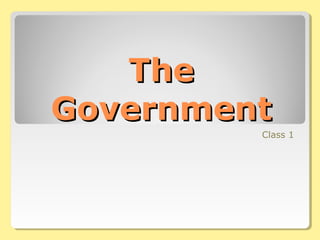Types of Government
- 2. Government is a type of organization which rules/ governs a country. Types of Governments & Leaders
- 4. Vocabulary Crossword T D H R E P R E S E N T A T I V E C O D O A T C L R E J U N T A M I A A T G O C M R O C A O C R Y R R N H S A U T O C R A C Y H D I R E C T C H R Y Y C P H Y Across 3. Type of democracy where citizens elect leaders to represent them in government 7. A small group that rules a country after taking it over by force 9. One person has all the power 10. Type of democracy where citizens are involved in day-today government Down 1. Recognizes God as the ultimate authority in government and law 2. One leader has absolute control over citizens’ lives 4. Citizens hold the political power 5. A small group of people has all the power 6. People are not subject to any nation or government 8. A king or queen rules the country
- 5. Theocracy can apply to any of these! Where would you put theocracy on this chart?
- 6. MONARCHY • A monarchy has a king, queen, emperor or empress. • The ruling position can be passed on to the ruler’s heirs. • In some traditional monarchies, the monarch has absolute power. • But a constitutional monarchy, like the UK, also has a democratic government that limits the monarch's control.
- 7. DICTATORSHIP • A country ruled by a single leader. The leader has not been elected and may use force to keep control. • In a military dictatorship, the army is in control.
- 8. DEMOCRACY • “Democracy” literally means “rule by the people.” • In a democracy, the people govern – by voting. Two METHODS of Democracy Direct Democracy Representative Democracy
- 9. TASK 2 Do You Know Your Forms of Government?
- 10. A or B? 1. Citizens often have no rights. A Democracy B Dictatorship
- 11. A or B? 2. Led by a king or queen. A Monarchy B Oligarchy
- 12. A or B? 3. Democracy where citizens elect others to serve in government. A B Direct Representative
- 13. A or B? 4. Citizens vote to elect their leaders. A B Democracy Monarchy
- 14. A or B? 5. Democracy where citizens participate in lawmaking themselves. A Direct B Representative
- 15. Task 3 Complete the chart
- 16. True or False? 1. A monarchy can be like a dictatorship or it can be part of a democracy. Example or Reason: True False Denmark / Saudi Arabia Example or Reason: 2. A dictatorship can also be a democracy. 3. A democracy can have both representative and direct characteristics at the same time. True False Citizens get no say in a dictatorship Example or Reason: True False Switzerland
- 17. Task 4 Identify That Government!
- 18. NORTH KOREA One man leads North Korea and controls its government. He also controls its ruling political party. The ruling party chooses candidates for an Assembly, and citizens vote. The candidates do not have opponents, so citizens have no choices. Form of Government: dictatorship __________________________________
- 19. DENMARK The people of Denmark elect representatives to sit in Parliament, a lawmaking body. The Queen of Denmark heads the country, but she only has a small role in government. The government is led by a Prime Minister, who is appointed from among the elected representatives. Forms of Government: monarchy __________________________________ and representative democracy __________________________________
- 20. BRAZIL Brazil is led by a president who is elected by the citizens. Citizens in Brazil elect a new president every four years. Citizens also elect representatives to serve in two different legislative bodies. Form of Government: representative democracy __________________________________
- 21. SWITZERLAND Citizens elect representatives to sit in two different lawmaking assemblies. But citizens also vote several times a year to decide on laws. Citizens can vote to propose their own laws or undo laws passed by their representatives. All citizens may vote directly on these laws. Forms of Government: representative democracy __________________________________ and direct democracy __________________________________
Editor's Notes
- {}
